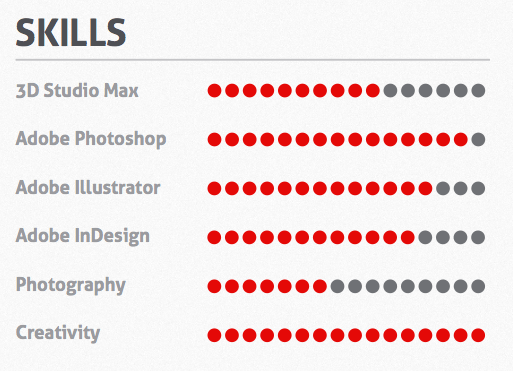Your CV sucks. No offense, but sure it does!
I said “no offense” but there is a ninety five percent chance that the designer who I tell this to will get offended. No designer likes to hear their CV’s being criticized, something they’ve spent hours on choosing the right font and right letter spacing; that awesome trending color palette they just found on Dribbble. Well, I hate to break it to you that it just isn’t good enough, and I am this gawd-awful judgmental bastard who is going to judge you from what you send me. Your CV sucks, man.
So what is the cure? How do I make a kick-ass CV? What does it take to make that perfect first impression? That love-at-first-sight kind of thing? What is a good CV, and why is the bar even higher for designers? Let’s find out.
Disclaimer: I don’t have much experience with the CV thing myself. I’ve never in my life been on the sending end of the CV business. All the jobs or ventures I’ve pursued in my life were either created of my own, happened to me by fluke, or I was “highly recommended” by someone and no screening was needed. So I had the privilege of skipping the whole CV/interview thing — unfortunately, you’re not me, and you need a good CV. And you can trust me because I have sifted through a ton of CV’s all my professional life and I can spot a good CV when I see it. 🤷🏻♂️
Bonus content: If you are looking for how to dazzle everyone in a designer’s job interview, read my previous blog.
Impact comes first
Impact always comes first. When you’re writing your CV, I am least bothered to know what your job responsibility was. I would want to know what impact you created. For example, “As a junior designer, I helped the team move 4x faster by introducing reusable design components library,” or “as a senior designer, I helped startup X raise $Y funding by helping them build out a proof of concept in Z number of weeks.” That’s the kind of thing that immediately draws my attention, and establishes your credibility. Please work on it. If you’re simply highlighting that you were “…a senior designer with experience in WordPress, Figma, Sketch and XD”, that’s going to be a hard pass.
Also lose the phrases like “I am a highly spirited”. You’re not alcohol for god’s sake to be highly spirited. Using cliched terms in your CV just makes you come across as lazy and uninspired. “Outgoing”, “results driven”, “forward thinking” are just silly filler words that have no real value.
Get rid of skills meter
 Yes, this stupid thing
Yes, this stupid thing
I don’t understand how some designers are able to quantify their skills using a progress meter. I’ve been in the business for 15 years and I still don’t know what percent good I am with Photoshop. I know I can get stuff done in Photoshop, but I don’t know if that is an 80% or an 82%, or an 83.75%. It amazes me how designers have this super dumb progress meters on their CV showing their 80% Photoshop and 75% Illustrator. I don’t think that is the right way to highlight your ability of handling a tool. A skill is never perfected. As a constant learner, you should say I have done Photoshop for 5 years rather than showing a 90% skill level. Don’t quantify skills, skills are not tangible or measurable things.
This takes me to the next point:
Nobody cares what tools you use
You don’t need to be a master of any tool to get a job. For highly specialized machinery, probably yes. But we’re not hiring you as a computer operator, we’re hiring you as a designer. So be one! Some exceptions to this could be if we’re looking for someone who we can immediately hire (because someone left or we needed them like yesterday) there is no good use of showing what tools you use. A doctor is not defined by how well they can handle the scalpel, neither should a designer be defined by how well they use Adobe XD. It takes less than a week for an XD user to switch to Figma, so there is no glory telling you’re good at it.
Irrelevant education is no good
I hardly care about your education. Unless you have a UX major from a big design school, I don’t think an engineering, law or a management degree adds up anything to who you are as a designer. Design is a hard skill that is shaped by years of interest and interaction. Formal education helps you know the why’s but you gotta figure out the what’s yourself. When enumerating my education accomplishments, I would highlight the highest and the most relevant education first. This in most cases is also the most recent degree. Also, secondary school like SLC/SEE is not much significant because that’s a foundational level degree that almost everyone has. I would safely assume that if you made it to Bachelors, you 100% passed your SLC. Otherwise you would not be there.
Dead links are horror stories 👻
It is always a good idea to include hyperlinks to your work. It really helps build context and I would love to see something that you designed living out there in the wild web. However, if it’s dead, it’s a good idea to remove it. Also, it is good idea to check if the link is still valid at the time of submitting the CV. I hate landing in dead links or parked domain spaces. It shows you were too lazy to check the external references to your link. Don’t do it, don’t be lazy.
Typos are provable: spell check before sending
It is always a good idea to check for spelling errors. It’s a harmless mistake but it’s important to build a good first impression. If you’re using a design software to design the CV, make sure you spot it using your good pair of eyes. Other word processors should tell you about spelling errors: find them, and fix them. Also, I bet you spotted the typo in the heading, it should be “probable” and not provable. I once had a candidate who spelled their last name incorrectly. Major face palm moment.
Use Grammarly.
A designer CV should look like a designer’s CV
Still stuck with Calibri in Microsoft Word? A CV itself should give a taste of your work. You would work on your CV with the same amount of responsibility you would show towards a commissioned client work. Make it pop. An aesthetically pleasing CV tells a lot about a good designer. Make sure you pay some attention to grid, layout, spacing and other things you would normally check. Please don’t be lazy.
A case study is not a part of the CV
If you have been asked to send a case study along with your CV, please note that these are separate set of documents. You don’t add details of your case study in the CV itself. A case study is a separate file that contains examples of your work, what you did, how you did it and what problem it solved. This should not be mixed up with other details like your work experience, etc. I’ve seen a CV that was several pages long where each of the work experience was accompanied by a project example. This is not the purpose of building out a CV.
Make it machine readable
Meaning to say, a lot of the recruiting app people use these days to hire candidates is probably a web-based service that can automatically parse the information. Many top HR apps do that; so make sure it’s not too funky. Automatic systems follow pattern and look for specific words or phrases to interpret the information so make sure it’s machine readable. Don’t try to impress humans with fancy design and layout and forget that the machines won’t be able to process your funkiness. Stay simple.
So yea, that’s about it. When you apply for a designer position anywhere, make sure to take notes of these few points. I’ve listed them here based on my experience. I hope it’s useful to you, and good luck with wherever you’re applying next!
